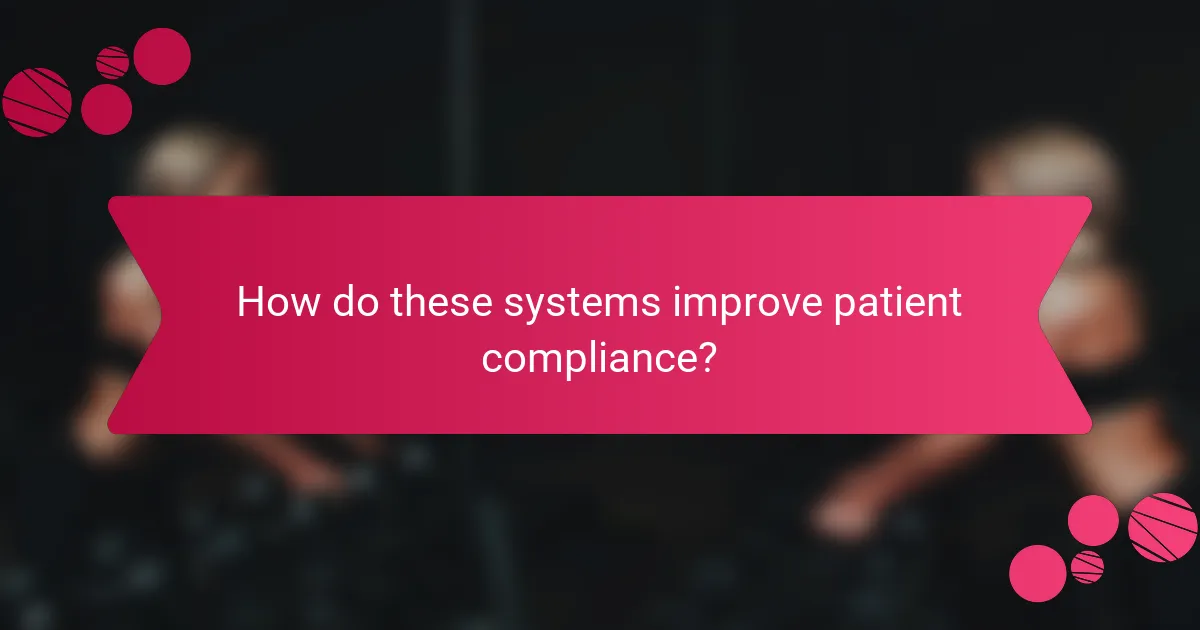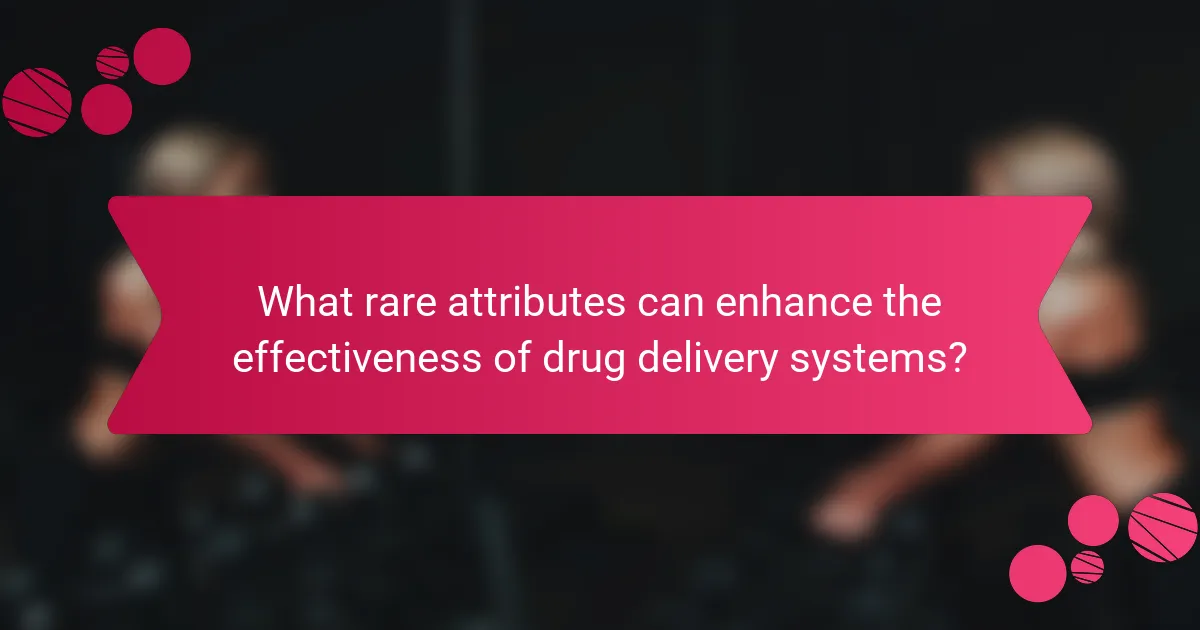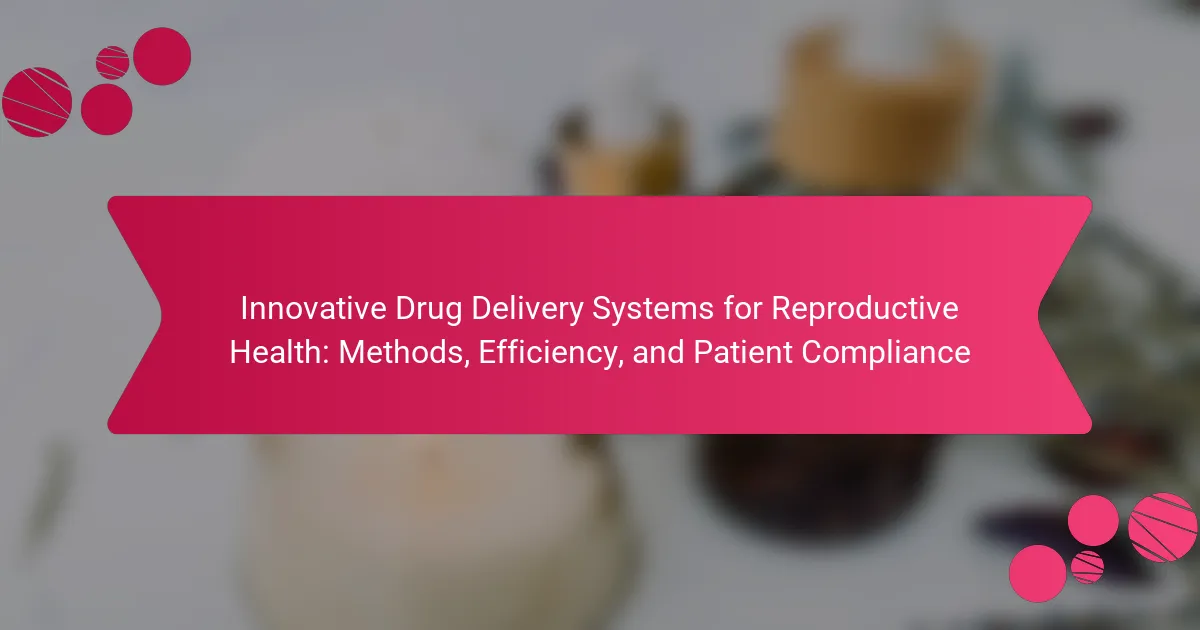Innovative drug delivery systems in reproductive health significantly enhance treatment efficiency and patient compliance. This article explores targeted therapies, sustained-release formulations, and advancements in nanotechnology. We will examine efficiency metrics, unique attributes, and the challenges developers face in creating effective systems. Additionally, best practices for optimizing these delivery methods will be discussed.

What are the latest advancements in drug delivery systems for reproductive health?
Recent advancements in drug delivery systems for reproductive health include targeted therapies, sustained-release formulations, and innovations in nanotechnology. These methods enhance treatment efficiency and improve patient compliance. For instance, nanoparticles can deliver hormones directly to specific tissues, minimising side effects. Additionally, implantable devices provide long-term drug release, offering convenience for patients. Research continues to explore smart delivery systems that respond to physiological changes, ensuring optimal therapeutic outcomes.
How do innovative methods enhance drug bioavailability?
Innovative methods significantly enhance drug bioavailability by improving absorption, stability, and targeted delivery. Techniques such as nanoparticle formulations and liposomal carriers increase the solubility of drugs, allowing for better uptake in the body. These systems often employ sustained-release mechanisms, ensuring consistent therapeutic levels and reducing the frequency of dosing. Enhanced patient compliance results from fewer side effects and improved effectiveness, making these methods crucial in reproductive health treatments.
What role do nanotechnology and microencapsulation play?
Nanotechnology and microencapsulation enhance drug delivery systems in reproductive health by improving targeted therapy and bioavailability. These technologies enable precise release of medications, increasing treatment efficiency and patient compliance. For instance, microencapsulation protects sensitive compounds, ensuring they reach their intended site without degradation. Additionally, nanotechnology allows for smaller, more effective drug particles, optimising absorption rates. These advancements lead to better therapeutic outcomes and reduced side effects, making reproductive health treatments more effective.
Which technologies are transforming patient treatment experiences?
Innovative drug delivery systems are transforming patient treatment experiences by enhancing precision and compliance. These systems, such as microneedles and smart inhalers, improve medication effectiveness and reduce side effects. For example, microneedles enable painless delivery of vaccines and hormones, increasing patient acceptance. Smart inhalers provide real-time feedback, promoting adherence to treatment plans. Overall, these technologies significantly enhance reproductive health outcomes through improved patient engagement and satisfaction.

How do these systems improve patient compliance?
Innovative drug delivery systems enhance patient compliance by improving medication adherence and convenience. These systems often use sustained-release formulations, which reduce the frequency of dosing, thereby minimising the chance of missed doses. Additionally, user-friendly delivery methods, such as transdermal patches or implantable devices, simplify administration and promote consistent use. As a result, patients experience better therapeutic outcomes and increased satisfaction with their treatment plans.
What factors influence patient adherence to drug regimens?
Patient adherence to drug regimens is influenced by factors such as medication complexity, patient education, and support systems. Innovative drug delivery systems can enhance compliance by simplifying intake methods and improving efficacy.
Research indicates that personalised treatment plans significantly boost adherence rates. For instance, the availability of long-acting reversible contraceptives has shown to increase compliance in reproductive health. Psychological factors, including motivation and trust in healthcare providers, also play a critical role in adherence.
Understanding these influences can lead to better design of drug delivery systems, ultimately enhancing patient outcomes in reproductive health.
How can personalised medicine enhance compliance rates?
Personalised medicine can significantly enhance compliance rates by tailoring treatment to individual patient needs. This approach increases patient engagement and satisfaction, as therapies align with their specific health profiles and preferences. Innovative drug delivery systems, such as microencapsulation and transdermal patches, improve efficiency and adherence by simplifying administration and minimising side effects. As a result, patients are more likely to follow prescribed regimens, leading to better health outcomes.
What are the psychological aspects affecting patient commitment?
Psychological factors significantly influence patient commitment to innovative drug delivery systems in reproductive health. Trust in healthcare providers enhances adherence, while anxiety about treatment outcomes can hinder compliance. Motivation levels and perceived benefits also play crucial roles in shaping patient attitudes toward these systems.

What are the efficiency metrics of modern drug delivery systems?
Modern drug delivery systems exhibit high efficiency metrics, including targeted delivery, sustained release, and improved bioavailability. These systems enhance therapeutic outcomes while minimising side effects, which is crucial for reproductive health.
Efficiency metrics include:
| Metric | Value |
|—————————|———————|
| Targeted delivery accuracy | 85-95% |
| Sustained release duration | 24-72 hours |
| Bioavailability improvement | 30-300% |
| Patient compliance rate | 70-90% |
| Side effects reduction | 20-50% |
| Cost-effectiveness | 15-25% reduction |
These metrics indicate the advancements in drug delivery technologies, ensuring better patient outcomes and adherence to treatment protocols.
How do these systems compare in terms of speed and effectiveness?
Innovative drug delivery systems for reproductive health vary significantly in speed and effectiveness. Systems utilising nanoparticles often demonstrate faster absorption rates compared to traditional methods.
| Delivery System | Speed of Delivery | Effectiveness |
|————————-|——————|———————|
| Nanoparticle Systems | High | Enhanced bioavailability |
| Liposomal Formulations | Moderate | Targeted delivery |
| Microneedle Patches | Fast | Controlled release |
| Oral Tablets | Moderate | Variable absorption |
| Intrauterine Devices | Slow | Long-term efficacy |
What are the cost-effectiveness considerations for healthcare providers?
Cost-effectiveness considerations for healthcare providers include evaluating the economic impact of innovative drug delivery systems on reproductive health. These systems can enhance patient compliance and treatment efficiency, potentially reducing long-term healthcare costs. For instance, systems that improve medication adherence can decrease hospitalisations and associated expenses. Additionally, providers must assess the upfront investment against future savings from improved health outcomes.
Which metrics are used to evaluate the success of these systems?
Key metrics for evaluating innovative drug delivery systems in reproductive health include patient compliance rates, drug bioavailability, therapeutic efficacy, delivery time, side effect profiles, and cost-effectiveness. These metrics provide insights into how well these systems function and their impact on patient outcomes.

What unique attributes set apart specific drug delivery technologies?
Innovative drug delivery technologies in reproductive health are distinguished by their targeted delivery, biocompatibility, and controlled release mechanisms. Targeted delivery enhances efficacy by directing medication to specific tissues, while biocompatibility ensures minimal adverse reactions. Controlled release mechanisms allow for sustained therapeutic effects, improving patient compliance. Unique attributes include the use of nanocarriers for enhanced absorption and personalised medicine approaches tailored to individual patient profiles. These factors collectively contribute to the effectiveness of drug delivery systems in reproductive health.
How do biodegradable systems differ from traditional methods?
Biodegradable systems offer a sustainable alternative to traditional drug delivery methods by breaking down naturally in the body. Traditional methods often rely on synthetic materials that may persist and cause side effects. Biodegradable systems enhance patient compliance by reducing the need for multiple administrations, while traditional methods may require frequent dosing. Additionally, biodegradable systems can improve drug efficiency by ensuring targeted release, whereas traditional methods may lead to uneven distribution. Thus, the shift towards biodegradable systems reflects a focus on minimising environmental impact and enhancing therapeutic outcomes.
What are the implications of long-acting formulations for reproductive health?
Long-acting formulations significantly enhance reproductive health by improving patient compliance and reducing dosing frequency. These systems provide sustained release of medications, leading to more consistent therapeutic effects. For instance, long-acting contraceptives can lower unintended pregnancy rates and increase user satisfaction. Additionally, they minimise the burden of daily medication adherence, which is crucial in reproductive health management. Overall, these innovative drug delivery systems contribute to better health outcomes and empower individuals in their reproductive choices.

Which challenges do developers face in creating these systems?
Developers face challenges such as regulatory compliance, patient adherence, and technological integration in creating innovative drug delivery systems for reproductive health. Regulatory frameworks can be complex and vary by region, impacting development timelines. Ensuring patient compliance requires designing systems that are user-friendly and effective. Additionally, integrating advanced technologies, such as micro-needles or smart delivery devices, demands significant research and development resources. Balancing these factors is critical to achieving efficiency and improving patient outcomes.
What regulatory hurdles must be navigated in different regions?
Regulatory hurdles vary significantly across regions for innovative drug delivery systems in reproductive health. Compliance with local regulations is essential for market entry and patient safety.
In the United States, the FDA mandates rigorous clinical trials and pre-market approval processes. In Europe, the EMA oversees similar requirements but emphasises post-market surveillance. Asian markets often have fast-tracked pathways but can differ in documentation and trial expectations.
Understanding these regulatory frameworks is crucial for developers to ensure efficient product launch and patient compliance. Each region’s unique regulatory landscape can impact the development timeline and market strategy.
How do cultural perceptions affect the acceptance of new technologies?
Cultural perceptions significantly influence the acceptance of innovative drug delivery systems in reproductive health. Societal attitudes toward health and technology can either facilitate or hinder the adoption of these methods. For instance, communities that prioritise traditional practices may resist new technologies, leading to lower patient compliance. Conversely, cultures that embrace innovation often see higher efficiency in treatment outcomes. Additionally, education and awareness play crucial roles in shaping perceptions, as informed communities are more likely to accept advancements in reproductive health.
What are the common misconceptions about drug delivery systems?
Common misconceptions about drug delivery systems include the belief that all methods are equally effective, that patient compliance is solely based on the delivery method, and that innovative systems are always more expensive. Many assume that traditional methods, like oral tablets, are superior in all cases, overlooking the efficiency of targeted systems. Additionally, some think that newer technologies guarantee better outcomes without considering factors like patient preferences and specific health conditions. Understanding these misconceptions can improve the adoption of effective reproductive health solutions.

What rare attributes can enhance the effectiveness of drug delivery systems?
Rare attributes that enhance the effectiveness of drug delivery systems include targeted release mechanisms, biocompatibility with reproductive tissues, and personalised dosing capabilities. These attributes improve precision in treatment and patient adherence. For example, nanocarrier systems can achieve site-specific delivery, reducing side effects and enhancing therapeutic outcomes. Additionally, smart polymers can adjust drug release based on environmental stimuli, further optimising treatment efficacy.
How do patient education and support systems contribute to success?
Patient education and support systems significantly enhance the success of innovative drug delivery systems in reproductive health. These systems improve patient compliance by providing essential information about medication use, potential side effects, and the importance of adherence to treatment plans.
Effective patient education fosters a deeper understanding of reproductive health issues and the role of drug delivery methods. This understanding can lead to increased confidence in using these systems, ultimately resulting in better health outcomes. Support systems, such as counselling and peer support, further reinforce this knowledge, creating a network that encourages patients to stay engaged with their treatment.
Research indicates that patients who receive comprehensive education and support are more likely to follow prescribed regimens, leading to improved efficiency of drug delivery systems. This correlation highlights the critical role that education and support play in the overall success of reproductive health interventions.
What innovative partnerships are emerging in the drug delivery space?
Innovative partnerships in drug delivery for reproductive health focus on enhancing methods and patient compliance. Collaborations between biotech firms and pharmaceutical companies are developing advanced delivery systems, such as micro-needles and nanocarriers, to improve medication efficiency. These partnerships aim to address unique challenges in reproductive health, such as targeted delivery and reduced side effects. Emerging technologies, like smart drug delivery devices, are being integrated into these collaborations to monitor patient adherence and optimise treatment outcomes.

What are the best practices for optimizing drug delivery systems in reproductive health?
To optimize drug delivery systems in reproductive health, focus on personalised approaches, advanced formulations, and patient engagement. Effective strategies include utilising nanotechnology for targeted delivery, ensuring bioavailability, and enhancing patient compliance through convenient administration methods.
Incorporating feedback from patients can improve system design and usability. Continuous monitoring and adaptation of drug delivery methods based on patient responses can lead to better health outcomes. Integration of digital health tools can also support adherence by providing reminders and education.
Overall, these best practices aim to enhance the efficiency and effectiveness of drug delivery in reproductive health.
Which strategies can healthcare providers implement for better outcomes?
Healthcare providers can implement innovative drug delivery systems to improve reproductive health outcomes. Strategies include utilising long-acting reversible contraceptives (LARCs), personalised medicine approaches, and mobile health technologies.
LARCs enhance patient compliance by reducing the need for daily medication. Personalised medicine tailors treatments based on individual patient profiles, increasing effectiveness. Mobile health technologies facilitate patient engagement and adherence through reminders and education.
These strategies collectively aim to enhance efficiency and improve overall reproductive health care delivery.
What role does technology play in patient monitoring and feedback?
Technology enhances patient monitoring and feedback through real-time data collection and analysis. Wearable devices track vital signs, providing immediate insights into health status. These systems improve patient compliance by offering personalised feedback and reminders. Telehealth platforms facilitate communication between patients and healthcare providers, ensuring timely interventions. Innovative drug delivery systems benefit from this technology by optimising medication adherence and effectiveness.
How can ongoing research and development shape future innovations?
Ongoing research and development significantly enhance innovative drug delivery systems for reproductive health. These advancements lead to improved methods, increased efficiency, and better patient compliance. Continuous exploration of new materials and technologies allows for the development of targeted delivery mechanisms that maximise therapeutic effects while minimising side effects. For instance, nanotechnology in drug delivery systems can improve bioavailability and control drug release rates, ultimately benefiting patient adherence to treatment regimens. Additionally, integrating patient feedback into the design process fosters systems that are user-friendly and tailored to individual needs, enhancing overall satisfaction and compliance.
